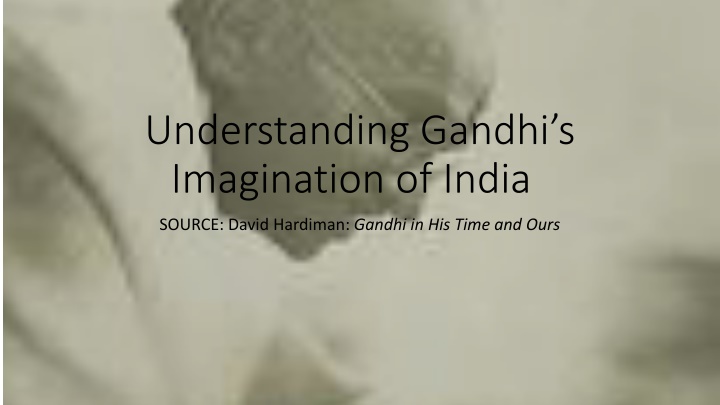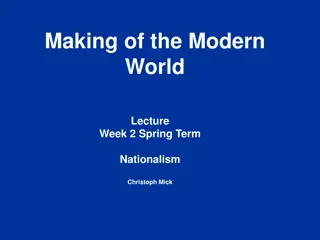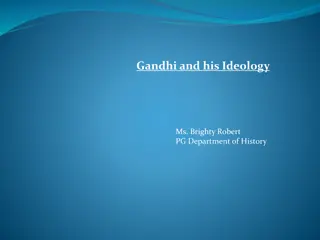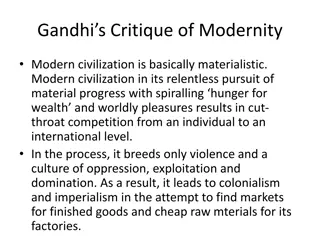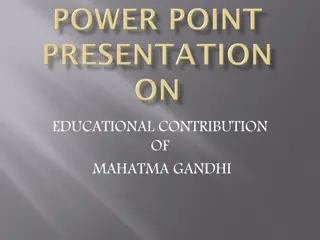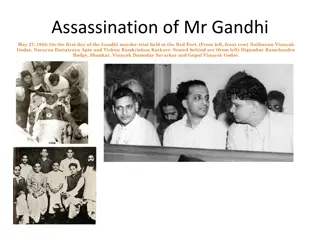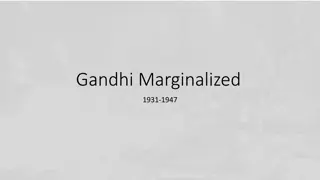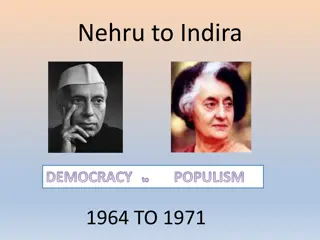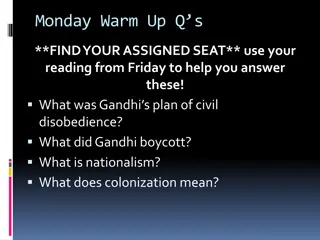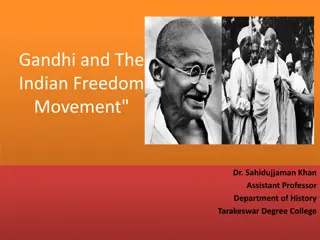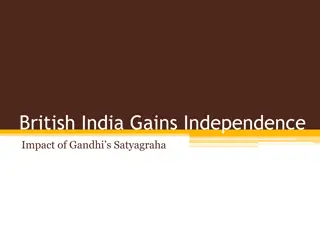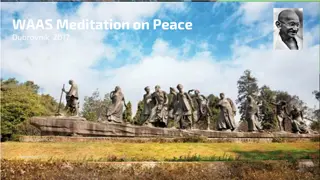Gandhi's Vision of Inclusive Nationalism
Gandhi's imagination of India was founded on principles of inclusivity and moral appeal, seeking to bring together diverse communities through non-dogmatic dialogue and debate. He envisioned a nation built on karma and harmony, rejecting materialism and advocating for self-discipline over state control.
Download Presentation

Please find below an Image/Link to download the presentation.
The content on the website is provided AS IS for your information and personal use only. It may not be sold, licensed, or shared on other websites without obtaining consent from the author.If you encounter any issues during the download, it is possible that the publisher has removed the file from their server.
You are allowed to download the files provided on this website for personal or commercial use, subject to the condition that they are used lawfully. All files are the property of their respective owners.
The content on the website is provided AS IS for your information and personal use only. It may not be sold, licensed, or shared on other websites without obtaining consent from the author.
E N D
Presentation Transcript
Understanding Gandhis Imagination of India SOURCE: David Hardiman: Gandhi in His Time and Ours
If the nation is an Imagined Community, what SORT OF NATION WAS GANDHI GANDHI IMAGINING?
Why and How does Gandhi imagine the nation? *personal experience of racism * fight for equal citizenship of empire in South Africa shaped his vision of nationalism, DIALOGISM, always open to, welcome debate No FIXED PHILOSOPHICAL system (others called it GANDHISM) For himself, it was a search for truth which was always evolving. No grand political theory. Welcome debate and discussion. Not always practice what he preach, but open to discussion, and changed his mind often enough on IMPORTANT issues, that we can see him as someone who was not dogmatic
What sort of Nation? Hardiman says Gandhi s nationalism had little in common with the collectivist, monolithic, aggressive and xenophobic nationalism of some of the Western and Central European countries (16) Nationalism was Incorporative. Hindu and Muslim and others. He did not always succeed, but PRINCIPLE was incorporative not parochial. Unlike that of many peers Not unique, nor first to do so, Gandhi s composite nationalism BUILT On these ideas, an IMAGINATION of India as loose constellation of communities, whom he sought to bring together through appeal to MORAL issues, whether it be Rowlatt Act, Khilafat, or Salt. *Not anti British per se, as long as they change their approach to India and to what they value, not a chauvinistic nationalism *nationalism based on karma, not bhoga (where material pleasure takes on an almost spiritual dimension, love for cars, or homes, or possessions, these cannot be objects of love according to Gandhi) Karma otoh = good conduct su- dharo *REVERSED British stereotype of always, inevitably divided, caste-ridden, stagnant, India to claim it was always a nation, harmonious etc.
What sort of State? *Believes in dynamic political space outside of state, for private property, trusteeship, as counter to state, so not believe in power politics, even asked INC to disband in 1948 *Although he tempered his argument about the state in later years, still suspicious of it. Wanted minimalist government. But did agree in later years that poor and oppressed needed state, and also to curb communal violence. (21) * Both something in common with but also deeply antithetical to anarchism. Gandhi believed strongly in discipline, but SELF discipline, not by state, and certainly not violence (20-21)
Reworking Older Ideas Gandhi not the first to use either AHIMSA, SATYAGRAHA, or even CIVIL DISOBEDIENCE in India. But represented a highly creative intervention (41) in its theory and practice Hardiman recounts a long history to Civil Disobedience (CD) Jodhpur, Surat merchants {42-43} Dharna {44-45} even threat of suicide ({46} or self moritfication {46-47} etc] British have no respect for these traditional forms of protest, criminalize them, often crush by force (48-9)] Modern states that claim to follow rule of law but monopolize violence are more susceptible to Civil Disobedience DIALOGIC RESISTANCE goes to the very heart of what Gandhi s ideas were all about. DIALOG was key Through opening a dialog, try to persuade the opponent of your truth. An example is the use of PUBLICITY, which is what G use for first Satyagraha Champaran (49-50) discussed earlier What G did was to rework older forms of CD to suit both his key moral concepts and new realities. Thus protest not motivated by hatred of opponent, but with desire to persuade, to open channels of communication Gandhi created new language of protest that both built on older forms of resistance while at the same time accepting the colonial censure of all forms of violent protest. In time his new methods were to become as ritualized as the older forms of resistance (51)
Satyagraha and Ahimsa Satyagraha, truly dialogic, change heart of opponent, in satyagraha there are no enemies (52) opposed by others, who felt like collaboration. Gandhi said look at results, if you pressure, no heart change, victory is only partial only when the opponent had understood the force of the counter-argument and had acted on that basis that there would be any genuine and durable success. (54) Gandhi used BOTH, moral argument and non violent coercion (fast, mass protest) as H says What was crucial ... was his political skill in knowing which line to play at each twist and turn. (54) Individual Conscience important to Gandhi, which he took from Thoreau, Tolstoy, Quakers, but it could not be ONLY a matter of individual action. However, no coercion or pressure, e.g. through sanctions of caste or community. Yet, this did and does happen, despite G saying no society can be built on a denial of individual freedom (57) Ahimsa older tradition, again reworked, not a technical ahimsa of Jaina baniya e.g. (58) insist on truth but not by inflict suffering on opponent but oneself (59) not out of cowardice, quite the opposite, strength The question of whether or not it can be used in face of implacably violent enemy is very debatable, G probably wrong in asking Jews to use it against Nazis, though some successes (of Aryan spouses of Jews imprisoned (61) REPEAT: Modern states that claim to follow rule of law but monopolize violence are more susceptible to Civil Disobedience
Gandhi and Swaraj WHAT DOES Gandhi mean by SWARAJ? Multivalent word. Means self rule, but does that mean we will rule over our own people or we need to have control over ourselves? As we will see from Hind Swaraj, Gandhi used the term to include BOTH MEANINGS. For his SWARAJ as much about SELF DISCIPLINE as HOME RULE So for Gandhi s political actions as well as for the moral regeneration he sought, DISCIPLINE was paramount. This included individual self restraint and self discipline, variety of ways, celibacy particularly important. BUT ALSO COERCIVE DISCIPLINE when necessary, but, as Hardiman says, his was very different discipline, from that of later Gandhians such as Desai or Vinoba Bhave (31-32)
Nation Above All? (Not STATE, nation!) A strength or weakness of Gandhian nationalism was that it sought to be BEYOND ALL DIVISIONS Overlook differences of CLASS, CASTE, or GENDER INDIA...bound together not by interests but by neighborliness (we will discuss some limitations later, peasants and women) This worked sometimes, and not at others. Because sometimes local and national were well connected, well articulated, such as in Bardoli in 1928, but in other cases, such as Chauri Chaura in 1922, not so, where the local issues that had brought the folks in Chauri Chaura to Gandhian Satyagraha were hardly resolved when G decide to call off movement because of violence In part, though only in part, thanks to this disarticulation, came Gandhi s notions of what H terms the DISCIPLINED NATION. Perhaps because of frequent DISARTICULATIONS, G very emphatic on DISCIPLINE Also created some CONTRADICTIONS. We will explore those in our reading of Hind Swaraj
